
Villas and palaces in Milan are used to indicate public and private buildings in Milan of particular artistic and architectural value. Milan has always been an important centre with regard to the construction of historical villas and palaces, ranging from the Romanesque to the neo-Gothic, from Baroque to Rococo.

Piazza Cordusio is a square in central Milan, Italy. The piazza takes its name from the Cors Ducis which was located on the square during Longobard times. It is well known for its several turn-of-the-19th-century Neoclassical, eclectic and Art Nouveau buildings, banks and post offices. Even though many of these have now relocated elsewhere, it is still an important commercial square in the city and hosts the Palazzo delle Assicurazioni Generali, the Palazzo del Credito Italiano and the Palazzo delle Poste, former Borsa di Milano. Piazzale Cordusio hosts the Cordusio metro station and is the starting point of the elegant pedestrian Via Dante which leads to the imposing medieval Castello Sforzesco, or Milan Castle. Opposite to Via Dante, Cordusio borders onto Piazza Mercanti, former city centre in the Middle Ages, which leads directly to Piazza del Duomo, today's city centre.

Casa degli Omenoni is a historic palace of Milan, northern Italy, located in the eponymous street of Via degli Omenoni. It was designed by sculptor Leone Leoni for himself; he both lived and worked there. It owes its name to the eight atlantes decorating its facade, termed "omenoni", which were sculpted by Antonio Abondio, most probably on a design by Leoni. Lions are a recurring theme of its decorations; in particular, a large relief placed under the cornice depicts two lions tearing a satyr into pieces. The overall style of the palace and the decorations have been noted to include several references to the art of Michelangelo. The internal courtyard, modified in 1929 by Piero Portaluppi, has a colonnade with metopes and triglyphs.
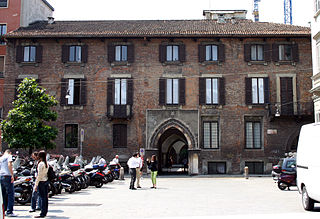
Palazzo Borromeo is a 14th-century building located at piazza Borromeo 12 in Milan, region of Lombardy, Italy. It was built as the home and business headquarters of the Borromeo family, merchant-bankers from Tuscany. Some of the building complex was badly damaged during World War II in Allied bombings of 1943 but was reconstructed and restored to its 15th-century appearance. It contains an important fresco cycle from the 1440s and is one of the finest examples of a Milanese patrician palace from the early Renaissance.

Palazzo Mezzanotte, also known as Palazzo delle Borse is a 20th-century building of Milan, Italy, and the seat of the Italian stock exchange. It is located in Piazza Affari, the city square after which the Italian stock exchange itself is nicknamed. The name "Palazzo Mezzanotte" is a reference to Paolo Mezzanotte, the architect who designed the building.

Casa Manzoni is a historical palace sited in via Morone 1 near the quadrilateral of fashion in the center of Milan, Italy. Owned by the Manzoni family, the house was the birthplace of the famous Italian writer Alessandro Manzoni in 1785.

Casa Guazzoni is a building at via Malpighi 12 in Milan in the Liberty style, or Italian Art Nouveau.

Palazzo Arese was a 16th century baroque palace and seat of a branch of the House of Arese in Milan, Italy. It was located adjacent to Casa Fontana Silvestri near the Porta Orientale. The palazzo was demolished in 1943 following damage sustained during the bombing of Milan in World War II.
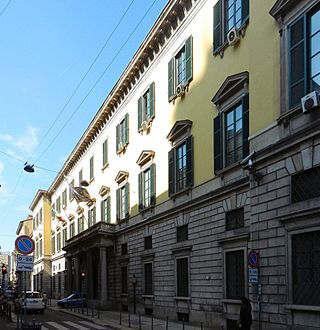
The Prefecture, Milan, also known as Palazzo Diotti, is a historic neoclassical building which has been the location of the office of the Prefect of Milan since 1859. The building is situated at 31, Corso Monforte in the city.
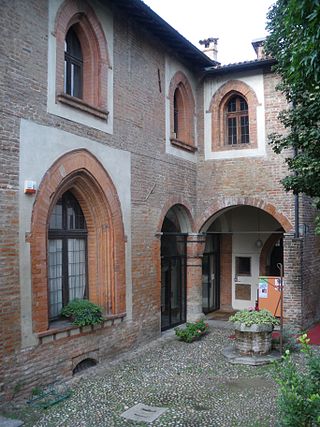
The Casa degli Eustachi is a medieval palace in Pavia in Lombardy.

Art Nouveau in Milan indicates the spread of such artistic style in the city of Milan between the early years of the 20th century and the outbreak of the First World War. In the Lombard capital, art nouveau, called StileLiberty in Italian, found—thanks to its close relationship with the rampant industrial bourgeoisie of the time—a fertile ground for its rapid development, during which it oscillated between the influences of French Art Nouveau, German Jugendstil and eclecticism.

Palazzo Cornazzani is a palace in Pavia, in Lombardy, where, between 1895 and 1896, Albert Einstein lived.

The Casa dei Grifi is a historic building in Milan, located in Via Valpetrosa 5.

Palazzo Carmagnola is a palazzo quattrocentesco in Milano, which was remodelled several times in the following centuries. Historically belonging to the Sestiere di Porta Comasina, it is located in via Rovello 2.
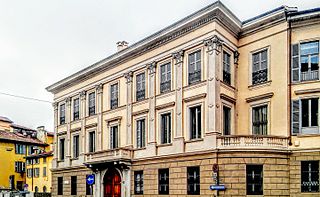
Palazzo Marietti is a historical building in Milan located in Via del Bollo No. 2.
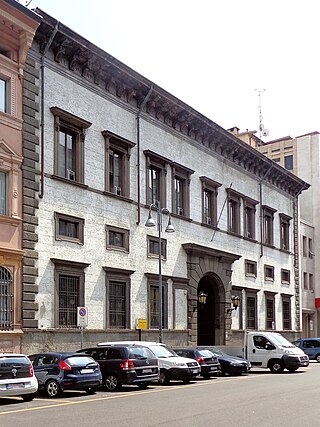
Palazzo Spinola is a 16th-century palazzo in Milan, heavily remodelled during the 19th century. Historically belonging to the sestiere di Porta Nuova, it is located at 10 Via San Paolo. Since 1808 it has been the seat of the Garden Society.

Palazzo Visconti di Grazzano, also known as Palazzo Visconti di Modrone or Palazzo Bolagnos, is a historical palace located in the centre of Milan, in Via Cino del Duca no. 8.
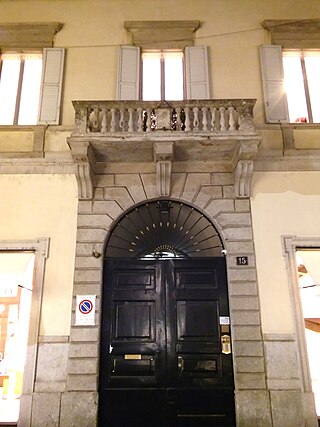
Casa Crespi is a historic building in Milan located at 15 Via Sant’Andrea.
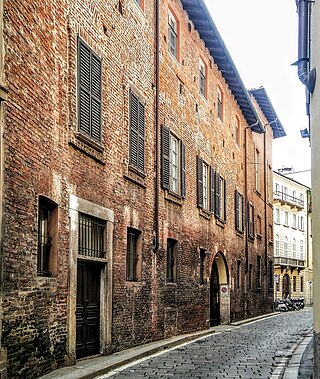
Casa Radice Fossati' is a historic building in Milan located at via Cappuccio no. 13

Palazzo Recalcati is a 16th century palace in Milan, enlarged between the 17th and 18th centuries. Historically belonging to the district of Porta Ticinese, it is located in Via Amedei 8.





















